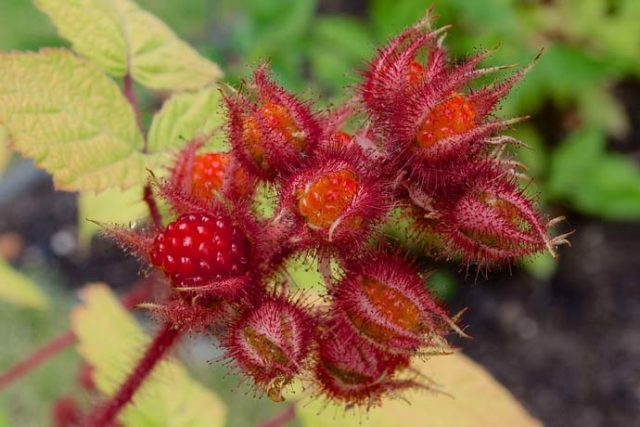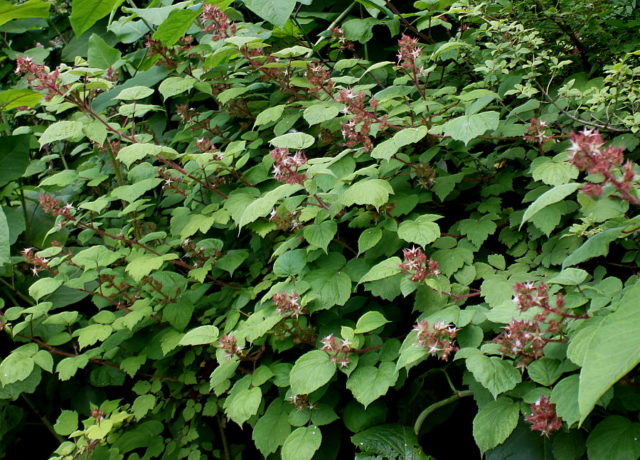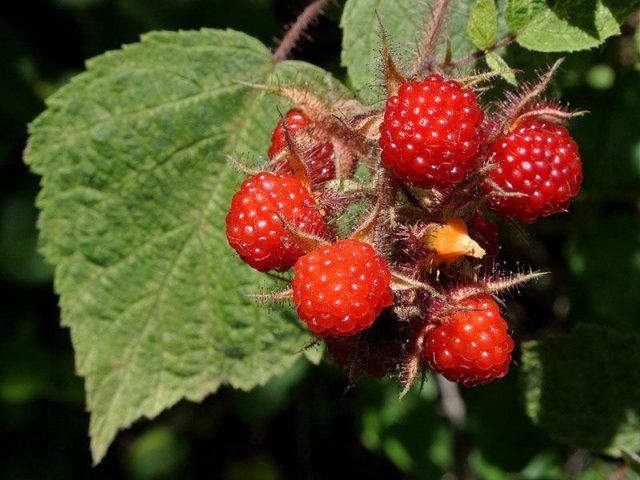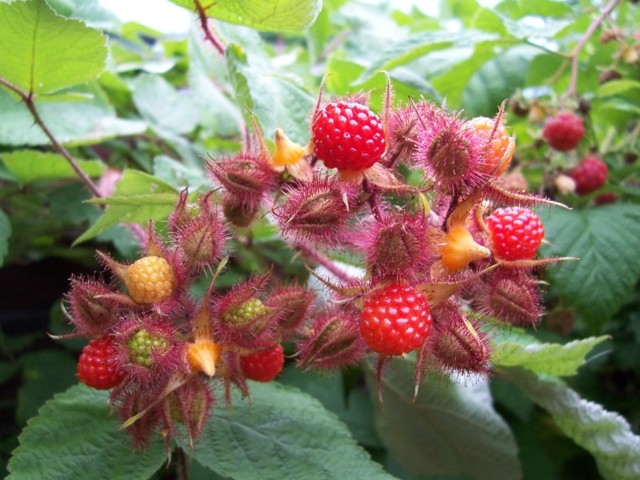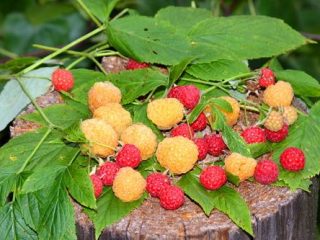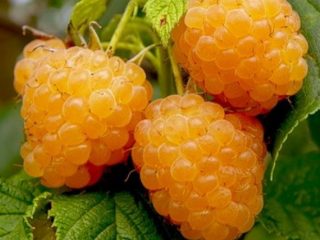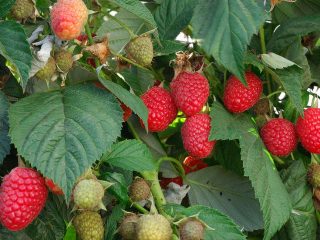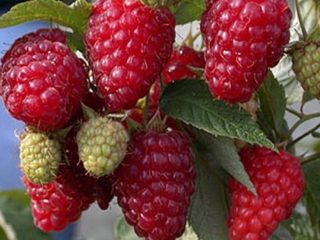Content
Japanese raspberries are a relatively new fruit bush for Russian gardeners. The variety has both strengths and weaknesses; to appreciate it, you need to study the characteristics of the unusual raspberry.
Description of Japanese raspberries
Japanese, or purple-fruited raspberry is a small subshrub up to 2 m in height with thin, reed-like stems. The photo of Japanese raspberries shows that the shoots of the plant are long, very curly and covered with small fleecy bristles, the leaves are dark green and feathery, with slight pubescence on the underside.
Japanese raspberries bloom in May with small red-pink flowers. The fruits are formed at the end of summer and ripen unevenly; ripe and developing berries may coexist in one cluster.
Pros and cons of Japanese raspberries
Recently, it has become very fashionable to plant Japanese raspberries in summer cottages.But before buying seedlings, you need to learn about the characteristics of the variety and understand that it has both advantages and disadvantages.
According to gardeners, Japanese raspberries have numerous strengths and demonstrate:
- high unpretentiousness and the ability to grow in almost any conditions;
- good resistance to all common garden pests and fungi;
- frost resistance, even without shelter, raspberries calmly endure winters throughout Russia;
- rapid growth and rapid recovery after pruning - the shrub can be used to form hedges and artistic compositions.
At the same time, Japanese raspberries are characterized by several serious disadvantages.
- Purple raspberry is a very aggressive garden crop. It grows quickly, actively produces root shoots and does not get along well with neighboring plantings. If left unchecked, raspberries can easily turn into a dangerous weed that will be very difficult to control.
- The yield of Japanese raspberries is low, and the berries are smaller in size than traditional varieties of the crop. Sometimes the difficulties that the fast-growing and aggressive purple-fruited raspberry creates simply do not pay off, since the benefit from the bush turns out to be small.
Nevertheless, many gardeners are keenly interested in Japanese raspberries. This variety can add originality to the garden and improve its decorative effect.
Applications of Japanese raspberries
Purple-fruited raspberries are distinguished by good preservation of berries - dense fruits tolerate transportation well and retain their shape.Therefore, raspberries are not only eaten fresh, but also actively used for preservation, made into wine, added to fillings for pies and cakes, consumed with ice cream and as part of cocktails.
Japanese raspberries contain many important vitamins and organic acids. Therefore, they are also used in folk medicine, to treat colds and inflammatory ailments, and to eliminate digestive problems. For example, hot tea with Japanese raspberries is an excellent antiviral agent and quickly reduces fever, and a homemade tincture of the fruits of the plant is suitable for treating the gastrointestinal tract and blood vessels.
Fresh Japanese raspberries can be used for cosmetic purposes. When added to face masks, berry pulp has a moisturizing and rejuvenating effect, nourishes and softens the skin. Japanese raspberries contain small seeds, so they are well suited for making gentle homemade scrubs.
Planting and caring for Japanese raspberries
Growing and caring for Japanese raspberries is usually not difficult - the shrub is considered one of the easiest to grow in a summer cottage. However, to get good yields from the plant, you need to know the basic rules of growing.
Selection and preparation of a landing site
Japanese raspberries have standard requirements for soil and light levels for berry bushes. It is best to plant the plant on slightly acidic or neutral fertile soil.The area should be well lit by the sun and protected from strong winds; it is also desirable that in the winter months a large amount of snow accumulates at the site where the raspberries are planted; it will serve as a natural insulation for the bush.
Japanese raspberry seedlings can be planted both in spring and autumn. About a month before planting, you need to prepare the soil - carefully dig up the area, remove the remains of other crops and weed out all the weeds. The soil is loosened and complex fertilizers are applied; the soil can also be mixed with rotted manure.
Landing rules
Planting raspberries in a prepared area is carried out according to the following algorithm:
- a hole is dug for the seedling, which should be approximately twice the size of its root system;
- if fertilizers were added to the soil when preparing the site, then the raspberries are planted immediately; if not, then organic fertilizer mixed with soil is first added to the hole;
- the seedling is carefully lowered into the hole and its roots are straightened, pointing them down;
- The young bush is covered with soil to ground level and the soil is compacted properly, making sure that the root collar is flush with the soil surface.
After planting, the seedling must be properly watered and the ground around the trunk mulched with peat, chopped straw or sawdust.
Watering and fertilizing
Japanese raspberries have moderate requirements for humidity levels.If there is no prolonged drought in the region, then it is not necessary to additionally water the shrub; it will make do with natural precipitation. During dry periods, raspberries can be moistened as the soil dries out, but you should not get too carried away - the plant does not respond well to waterlogging.
As for fertilizers, Japanese raspberries are fed once a year in the spring. About 30 g of urea, which promotes active growth of the plant, 50 g of superphosphate diluted with water, and about 30 g of potassium are added under the bush.
Trimming
The description of the Japanese raspberry variety emphasizes that the shrub is prone to very rapid and active growth. Therefore, it is necessary to prune the plant every year without fail.
Typically, pruning is carried out immediately after harvest. During it, all two-year-old shoots are removed, as well as diseased, broken and weakened branches. Shoots that thicken the bush also need to be cut off; they interfere with the healthy growth of raspberries and take away nutrients from the bush.
To improve fruiting, it is recommended to annually shorten annual shoots by about 20-30 cm. This stimulates the development of lateral shoots, on which buds are formed for the next fruiting, and the yield doubles. In addition, short raspberry branches are easier to care for and the berries are easier to pick from them.
Preparing for winter
Japanese raspberries are highly frost-resistant and can easily tolerate cold temperatures down to -30 °C. Therefore, it is only necessary to insulate shrubs in northern regions with extremely low winter temperatures. In other cases, natural snow cover will provide sufficient shelter.
For additional insulation of raspberries, the branches of the bush are tied in bunches, bent to the ground and fixed, and then covered with spruce branches or special material. If the winter is expected to be snowy, then the bush can simply be covered with snow - this will protect the shoots and roots of the bush from freezing.
Harvesting
The fruits of Japanese raspberries ripen in late August or early September. Numerous edible polydrupes of a slightly oblong shape appear on the shoots of the bush - they reach a length of up to 1 cm. At first, the raspberries take on a red tint, but upon reaching full ripeness they become dark cherry and purple.
For convenient harvesting, it is recommended to trim the fruiting branches of the bush to a length of no more than 1.5-2 m and fix them on trellises. Raspberries ripen gradually and unevenly - completely ripe and unripe berries can hang on the same brush. Therefore, harvesting is most often carried out several times throughout the fall.
Reproduction
As a rule, there are no problems with the propagation and transplantation of Japanese raspberries. The shrub reproduces successfully by all existing methods.
- It is most convenient to propagate raspberries using green cuttings; they are cut from an adult plant in the spring, leaving 3-4 internodes on each. Cuttings do not have to be grown in a home container; they can be immediately rooted in damp sand in a temporary bed or even planted in a permanent place. Rooting of shoots takes about a month - during this time the raspberries must be watered abundantly.After the cuttings produce new green leaves, watering will need to be reduced and additional moisture added to the garden bed no more than once every 10 days.
- Another convenient and easy way to propagate purple raspberries is to use layering. Young shoots located closest to the soil surface are tilted and secured in a small trench with wire, and then covered with earth. The tip of the shoot should remain above the soil surface. The cuttings are watered properly, and in the fall they can be separated from the main bush and transplanted to a permanent place.
Root shoots are often used as propagation material for Japanese raspberries - the bush produces them in huge quantities, and such shoots are ideal for rooting. The gardener has to make efforts not to propagate the shoots, but to tame its violent and extensive growth.
Diseases and pests
The shrub is rarely affected by diseases, since it is highly resistant to fungal diseases. The only danger to raspberries is purple spot. If the plant is weakened, this fungus can attack its stems and cause brown or purple spots to appear where the leaves attach. As it develops, purple spot provokes drying out of the bush and impairs its fruiting.
Purple spot can be cured with 1% Bordeaux mixture - spraying is carried out in the spring and after harvest.
Among the pests that are dangerous for Japanese raspberries are gall midges, spider mites and common aphids. To prevent infection of the bush or eliminate emerging insects, raspberries are treated annually with solutions of Actellik and Karbofos.
Conclusion
Japanese raspberries are an extremely convenient plant to grow; they require almost no special care, are highly frost-resistant and are not susceptible to fungal diseases. But when growing shrubs on a site, it is necessary to pay attention to regular pruning, otherwise the raspberries will grow too abundantly.
Reviews of Japanese purple raspberries
